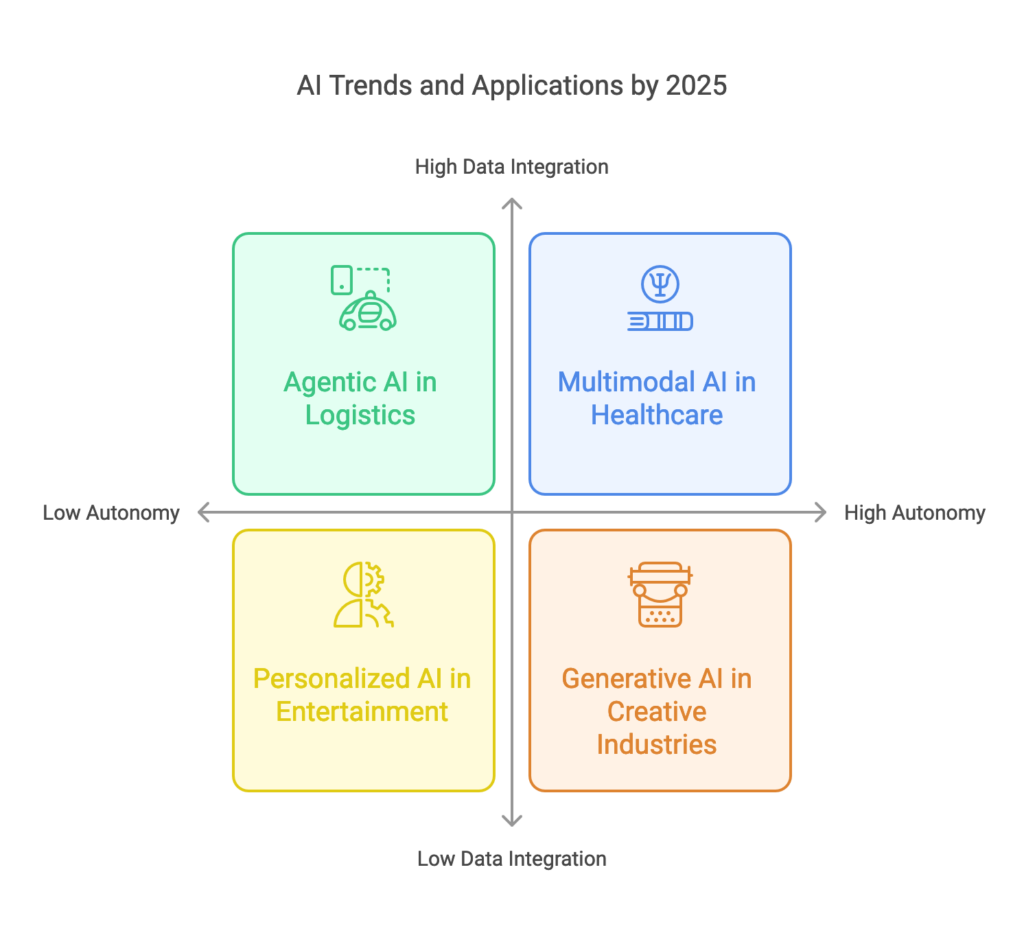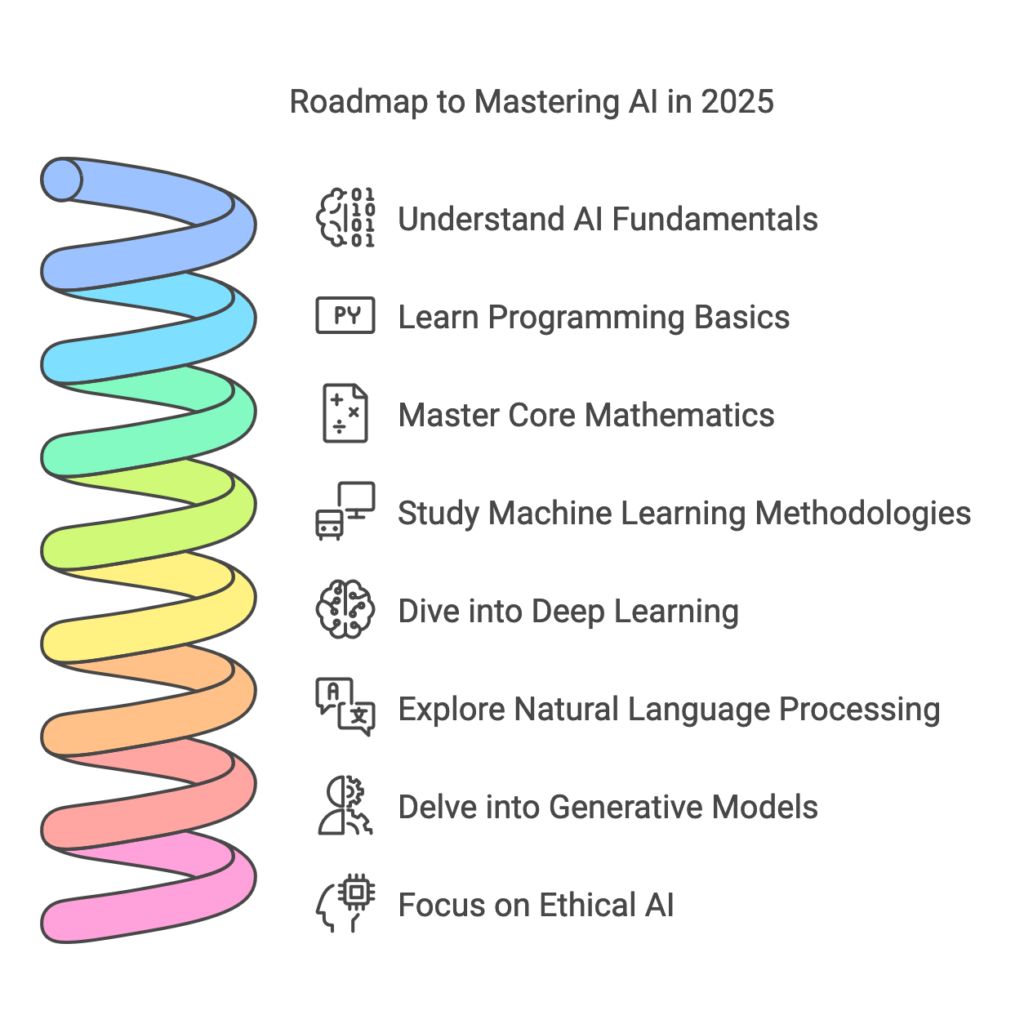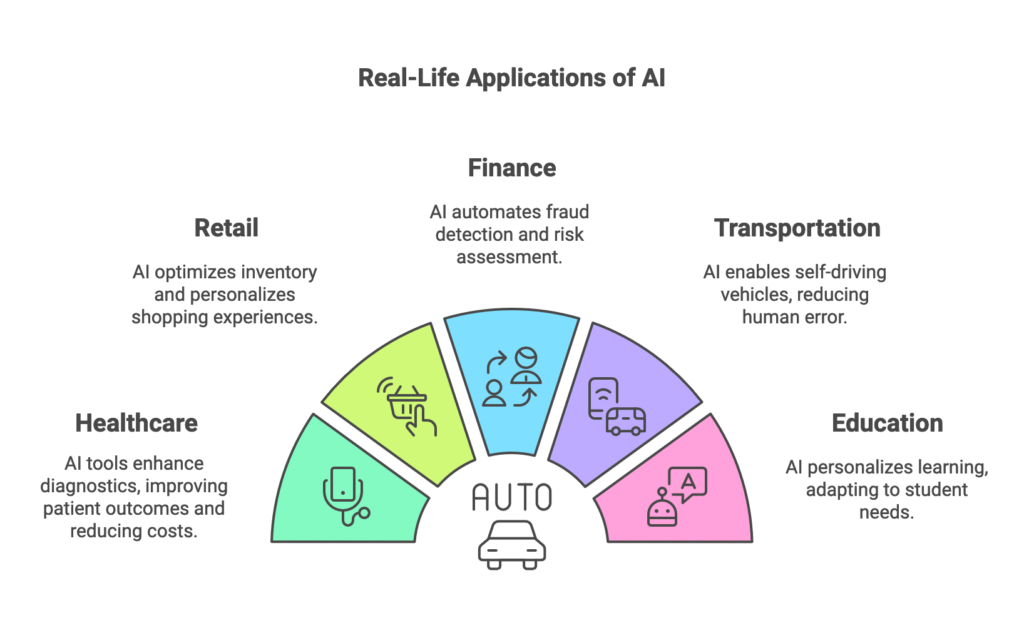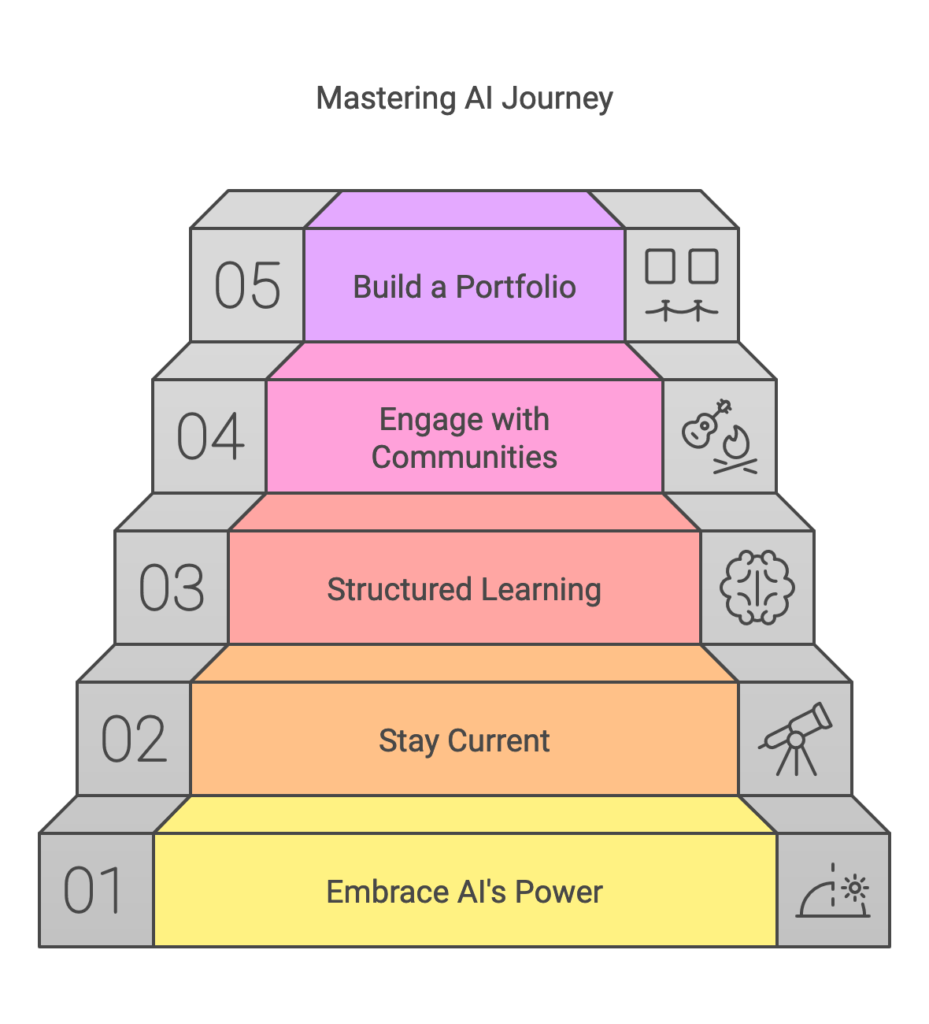Mastering AI in 2025: Trends, Skills, and the Ultimate Learning Roadmap

- Why AI Is the Future
- Emerging AI Trends for 2025
- Why You Should Learn AI Now
- Step-by-Step Roadmap to Master AI in 2025
- Essential Tools and Technologies for AI
- Real-Life Applications of AI
- Challenges in Learning AI
- The Role of Communities in Learning AI
- Building a Career in AI
- Conclusion and Next Steps
- FAQs
- AI School is pioneering in the learning space, offering cutting-edge programs that empower learners to excel in AI - join the programs offered by AI School to start your journey today!
Artificial Intelligence (AI) is fundamentally altering how we live, work, and interact with the world around us. By 2025, AI will be more prevalent and powerful than ever before, serving as a key driver of innovation across multiple industries. Below is a comprehensive guide that dives deep into AI trends, essential skills, and a detailed roadmap to help you master AI and stay ahead in this rapidly evolving field.
Why AI Is the Future
1.1. Massive Economic Impact
AI is expected to significantly contribute to global economic growth. As more businesses integrate AI into their processes—be it for supply chain optimization, customer service automation, or advanced data analytics—they see quantifiable benefits in terms of cost savings, revenue growth, and innovation opportunities.
- Operational Efficiency: AI automates repetitive and manual tasks, freeing up human resources for strategic, high-value roles.
- Data-Driven Insights: With AI analyzing massive data sets in real time, businesses can uncover hidden trends and make proactive decisions.
- New Markets & Services: Organizations that adopt AI often create entirely new revenue streams by offering AI-powered services to clients.
1.2. Industry Transformation
From healthcare to agriculture, AI’s transformative power is reshaping traditional business models:
- Healthcare: Machine learning models improve diagnostic accuracy, predict patient outcomes, and assist in developing personalized treatment plans.
- Agriculture: Precision farming uses AI-based sensors and analytics to maximize crop yield and minimize resource wastage.
- Entertainment: Recommendation algorithms personalize content, while AI-generated visual effects and scripts are increasingly common.
Each of these examples demonstrates how AI’s implementation is far more than just a technological upgrade—it’s a complete rethinking of how industries operate.
1.3. Workforce Evolution
The surge in AI adoption is also changing the job market. Some roles will become automated, but many new opportunities will emerge:
- AI Development & Engineering: Machine learning engineers, data scientists, and AI researchers.
- AI Integration Experts: Professionals who understand both AI and specific industry needs (e.g., AI in finance, AI in healthcare).
- Ethical AI & Compliance Officers: Specialists ensuring AI models are transparent, fair, and adhere to regulatory standards.
Far from eliminating the human element, AI is empowering people to focus on creativity, problem-solving, and strategic thinking.
Emerging AI Trends for 2025
2.1. Agentic AI
Agentic AI refers to AI systems capable of autonomous decision-making, operating with minimal human oversight. By 2025, such systems will be widespread in:
- Logistics: Automated route planning for deliveries, fleet management, and inventory optimization.
- Customer Service: Chatbots that handle complex queries and learn from each interaction to improve future responses.
- Manufacturing: Robots that not only follow programmed paths but also adapt to changes in real-time production lines.
2.2. Generative AI
Generative AI creates new content—text, images, audio, or video—based on patterns learned from existing data. By 2025, it will be indispensable for:
- Creative Industries: Scriptwriting, character design, and even digital art creation.
- Marketing Campaigns: Generating tailored messages for specific audiences with minimal human intervention.
- Rapid Prototyping: Designing product concepts or software user interfaces in record time.
2.3. Multimodal AI
Multimodal AI can interpret and combine different data types—text, images, audio, and even sensor data. By integrating multiple data streams, such systems deliver more accurate analyses and predictions:
- Healthcare Diagnostics: Merging patient histories, lab results, and imaging data for comprehensive evaluations.
- Security & Surveillance: Analyzing video feeds, audio signals, and text transcripts for threat detection and real-time response.
- Smart Environments: Homes and offices that understand context, adapting heating, lighting, and security protocols seamlessly.
2.4. AI in Cybersecurity
Cyber threats are evolving, making AI-driven cybersecurity crucial. By 2025, AI will be the backbone for:
- Threat Detection: Identifying unusual activity and zero-day vulnerabilities before they cause damage.
- Automated Incident Response: Responding to and containing cyberattacks faster than any human could.
- Predictive Security: Anticipating potential breaches by analyzing large datasets of past and real-time threat indicators.
2.5. Personalization in AI
Personalized AI will continue to refine user experiences, customizing everything from streaming content to product recommendations:
- Entertainment: Algorithms that learn viewers’ preferences to suggest new shows and movies.
- E-commerce: Tailored product suggestions and dynamic pricing strategies based on individual shopping behaviors.
- Online Education: Courses that adapt to each learner’s pace, focusing on areas where they need the most improvement.

Why You Should Learn AI Now
3.1. Growing Demand for AI Professionals
The global race to adopt AI technologies has created a talent shortage. Employers are seeking individuals with AI-centric skill sets to stay competitive, offering:
- Lucrative Salaries: Professionals in AI-related roles often command above-average compensation.
- Diverse Opportunities: AI skills are applicable in nearly every sector, from healthcare to retail to education.
3.2. Career Versatility
AI expertise goes beyond tech-focused job titles:
- Marketing: Predictive analytics can help design more effective ad campaigns.
- Finance: Algorithms can detect fraud, forecast market trends, and automate financial reporting.
- Human Resources: Applicant tracking systems powered by AI can streamline hiring and identify talent gaps.
3.3. Future-Proofing Your Career
With automation set to replace many routine tasks, possessing AI skills ensures long-term career resilience. Industries that are heavily reliant on data—such as finance, healthcare, and logistics—will favor professionals who can interpret and leverage AI insights.
3.4. Accessible Learning Resources
AI knowledge is more accessible than ever:
- Online Tutorials and Guides: Comprehensive, step-by-step resources for beginners.
- Interactive Learning Platforms: Simulated labs and quizzes for immediate feedback.
- Community-Driven Forums: Discussions, Q&A sessions, and peer support to clarify doubts.
Step-by-Step Roadmap to Master AI in 2025
Rather than diving in haphazardly, follow a structured approach to develop your AI expertise. Here’s a detailed roadmap:
- Understand AI Fundamentals
- Begin with the core concepts of AI, including machine learning, deep learning, and neural networks.
- Familiarize yourself with how AI models learn from data to make predictions or recommendations.
- Learn Programming Basics
- Acquire strong skills in languages commonly used in AI, such as Python.
- Focus on data handling, scripting, and basic logic structures before moving into advanced topics.
- Master Core Mathematics
- Develop proficiency in linear algebra, probability, statistics, and calculus—these are the bedrock of AI algorithms.
- Practice problem-solving to understand how mathematical principles underpin machine learning models.
- Study Machine Learning Methodologies
- Explore supervised, unsupervised, and reinforcement learning approaches.
- Understand different algorithm families like regression, classification, clustering, and decision trees, as well as the scenarios where each is most effective.
- Dive into Deep Learning
- Investigate neural network architectures such as convolutional neural networks (CNNs) and recurrent neural networks (RNNs).
- Experiment with building and tuning neural networks for tasks like image recognition and text analysis.
- Explore Natural Language Processing (NLP)
- Gain insights into how AI models interpret, analyze, and generate human language.
- Work on tokenization, sentiment analysis, and named entity recognition to build more nuanced text-based applications.
- Delve into Generative Models
- Study how AI can create new data by learning complex distributions.
- Experiment with models that generate text, images, or even music to understand the creative potential of AI.
- Focus on Ethical AI & Responsible Implementation
- Learn about bias detection, data privacy, and model transparency.
- Understand the societal impact of AI and how to mitigate ethical risks.
- Practice with Real-World Projects
- Apply your skills to solve real problems, whether it’s building a chatbot or analyzing a large dataset for insights.
- Aim to create a portfolio of projects that demonstrate both technical proficiency and creativity.
- Continuously Update Your Skills
- Subscribe to AI research summaries and news to stay informed about the latest breakthroughs.
- Engage in peer discussions and knowledge-sharing to refine your understanding and learn new techniques.
Following this step-by-step plan helps you gradually build a robust skillset that prepares you for the demands of the AI job market in 2025.

Essential Tools and Technologies for AI
5.1. Programming Languages
- Python: Boasts extensive libraries for data manipulation, machine learning, and deep learning.
- R: Used for statistical computing and data exploration, although less common for large-scale AI applications compared to Python.
5.2. Frameworks and Libraries
- Machine Learning Libraries: Comprehensive libraries that handle data ingestion, model building, and performance metrics.
- Deep Learning Frameworks: Flexible libraries that allow researchers and developers to build complex neural networks and scale them to production.
- NLP Toolkits: Specialized libraries for text processing, sentiment analysis, and language translation.
5.3. Cloud Platforms
- AI Services on the Cloud: Pre-built models and managed machine learning services expedite development, deployment, and scalability.
- Containerization & Orchestration: Tools that streamline the process of running AI models in scalable, cloud-native environments.
- Data Storage Solutions: Large-scale, high-throughput databases designed for real-time analytics and machine learning pipelines.
Real-Life Applications of AI
AI is not confined to theoretical research labs; it’s making a real-world impact:
- Healthcare: AI-powered diagnostic tools flag early signs of diseases, improving patient outcomes and reducing healthcare costs.
- Retail: Advanced demand forecasting tools help manage inventory levels, while personalized shopping experiences boost customer satisfaction.
- Finance: Automated fraud detection and risk assessment enable quicker, more accurate decision-making.
- Transportation: Self-driving vehicles use sensor data and AI algorithms for navigation, reducing human error.
- Education: Personalized learning platforms adapt course material to individual student needs, improving engagement and retention.
Each application emphasizes AI’s profound ability to interpret complex data, identify patterns, and make informed decisions at scale.

Challenges in Learning AI
While AI offers exciting opportunities, the learning journey can be rigorous. Common challenges include:
- Complex Concepts: AI requires a solid grasp of math, programming, and abstract thinking—topics that can feel daunting for beginners.
- Resource Overload: The abundance of online tutorials, videos, and articles can be overwhelming, making it hard to choose a focused learning path.
- Evolving Technologies: AI progresses at breakneck speed; staying updated means continually revisiting and refining your knowledge.
Overcoming These Challenges
- Structured Approach: Following a step-by-step roadmap prevents burnout and confusion.
- Collaborative Learning: Joining study groups or online communities helps you gain different perspectives and solve problems more effectively.
- Practical Projects: Hands-on experience not only reinforces theoretical knowledge but also sparks creativity and innovation.
The Role of Communities in Learning AI
Communities serve as catalysts for growth and innovation:
- Online Forums & Discussion Boards: Ask questions, get feedback, and share breakthroughs with a global pool of enthusiasts and experts.
- Local Tech Meetups & Workshops: Engage in face-to-face learning, networking, and collaboration.
- Hackathons & Competitions: Work on real problems under time constraints, honing both technical and soft skills.
Participating in communities accelerates your learning curve by offering fresh insights, mutual support, and real-world perspectives on AI challenges and solutions.
Building a Career in AI
A successful AI career is about more than just technical skills:
- Strong Portfolio: Showcase tangible projects—ranging from basic machine learning models to more advanced AI applications—demonstrating your ability to solve real problems.
- Continuous Learning: AI is an ever-evolving field; actively seek out new techniques, trends, and breakthroughs to stay ahead.
- Networking: Connecting with professionals, mentors, and thought leaders can open doors to job opportunities, partnerships, and collaborations.
- Soft Skills: Communication, teamwork, and ethical decision-making are crucial in multidisciplinary AI projects that involve multiple stakeholders.
Conclusion and Next Steps
Mastering AI is an ongoing journey. As you progress, the skills you acquire will remain highly relevant and adaptive to future innovations. Here’s a quick recap:
- Embrace AI’s Transformative Power: Understand the economic, social, and career-related implications of AI.
- Stay Current on Emerging Trends: Agentic AI, generative models, and multimodal systems will dominate the AI landscape in 2025.
- Follow a Structured Learning Path: From fundamentals to advanced AI techniques, build a strong foundation and then specialize.
- Engage with Communities: Learning in isolation can slow your growth; tap into collective wisdom and accelerate your progress.
- Build a Solid Portfolio: Real-world projects are the best way to demonstrate your abilities to potential employers or clients.

The AI revolution is here, and it’s poised to become even more pervasive by 2025. By following this comprehensive roadmap—covering everything from core fundamentals to the latest trends—you’ll position yourself as a valuable professional in a field that’s reshaping industries, economies, and the future of work.
FAQs
- What is the best programming language for AI?
While multiple languages exist, Python is often favored for its simple syntax and extensive libraries designed for data analysis and machine learning. - How long does it take to learn AI?
Mastery can take several years, but a solid foundational understanding can be achieved in a shorter timeframe with consistent, focused effort. - Are there free resources for learning AI?
Yes, a wide array of online tutorials, community forums, and open educational materials cater to beginners and advanced learners alike.
By committing to this journey and consistently updating your skills, AI won’t just be a buzzword—it will become a powerful asset in your professional toolkit. Stay curious, stay diligent, and watch your expertise grow along with this dynamic field.
AI School is pioneering in the learning space, offering cutting-edge programs that empower learners to excel in AI – join the programs offered by AI School to start your journey today!


